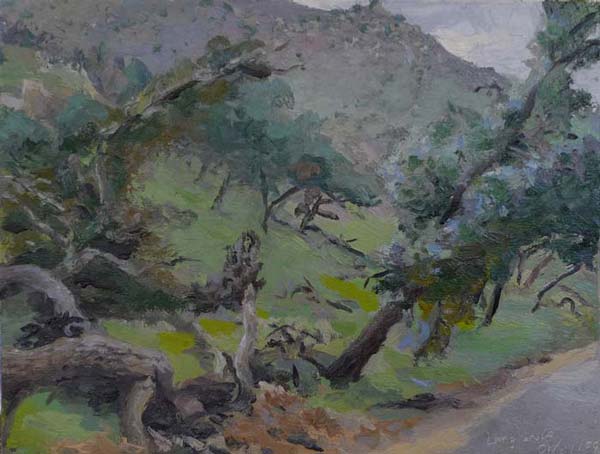
Oaks on a Hill 1/22/09 Larry Groff
Paul Cezanne said “Painting from nature is not copying the object; it is realizing one’s sensations. ”
Yesterday I was working on a painting of a grouping of oak trees growing or dying on a steep hillside, behind me was a majestic mountain side (El Capitan) that is the lure of many plein air painters here in San Deigo and the reason I drove all that way to paint in this quiet park at the end of rural road. But yesterday was cloudy and the mountain lacked the lighting drama I’d hoped for so this tree grouping was the day’s venture.
After an hour’s painting in the dark cloudy day, the sun lit up one of the trees for a few seconds, if I had just came here a snapped some photos for painting later on in the studio, I would have missed that moment. And only gotten one static view of the appearance of the place – not the sensation of actually being there taking in the whole scene as well as the selection. The changing light, the sounds of wildlife and the excitement of wondering what that loud rustling was in the nearby brush. I really need to learn more about mountain lions!
As it turns out I didn’t really paint that lighting moment but the sensation it gave me fueled the rest of the painting. I got a jolt of urgency that this painting was important to me, that I cared to get the right tones down and the right feel of the place. The percussive magic of nearby acorn woodpeckers tapping deep holes into the oaks so they can horde a single acorn inside that hole that they in all probability will completely forget about a few days from now. Sadly, I will probably forget about this painting in short time as I fell short of my goal to truly capture the magic I felt. But I was being true to my nature – for a brief moment, painting as if that was all that really mattered.





I truley enjoyed your article. Thank you.
thanks Jacquelyn, I’m glad you liked it.
That’s quite an unusual color scheme you’ve got going there yet I find it quite effective and moody. I suspect my eye is also attracted to the very steep hillside. Grew up in a very hilly area myself (upstate NY) and always seem drawn to such spaces in other people’s paintings. I realize sometimes it’s hard to separate out one’s responses to what one is looking at.
Larry,
Falling short of your goals, you wrote – I so understand that feeling! I often look at what I have just painted, and wonder if I have just ruined a perfectly good piece of wood. Even if we cannot capture what we saw and felt, the important thing is that we saw it, that we continue to wander around ready to perceive those moments. Sometimes we manage to get it, or at least think that we did, and that is when the “finished” thing feels rewarding. Sadly though I may look at it months later, and think, what a piece of stupidity! I then remind myself that the actual experience of perception and painting outweighs any failures of “product.” Thanks for sharing your painting moment. Beautiful result as well.
Yikes! I forget that some of my older posts might resurface with the new way this site is designed. This was a post I made when just starting this blog-before I decided to keep my painting out of this blog for the most part. For the record, this little painting wasn’t anything to write home about imho! I think it’s part of the nature of plein air painting that a certain percentage will fall short of your goals. Time runs out too quickly, you lose the light, break your concentration and it is often too easy to jump in before truly deciding what to paint and why. Of course you can always return and try again or just scrape it off but sometimes it’s easy to delude yourself about the success of the painting.
Part of what I was trying to get at with the acorn holes (which, I think, Rebecca alludes to) is that like the acorn woodpecker who pecks hundreds of little holes for his acorns, many acorns will be forgotten. But the net result of this process is the woodpecker has a plentiful food supply and a good life, presumably anyway – I’m no ornithologist! Even when we make stinkers it is all part of the process of becoming better painters, learning to recognize the many ways your painting can have shortcomings is vital to this never ending process. Painting monumental studio work that might take months you have a lot more on the line but the process is still the same.
Philip, the color scheme in the painting is a bit odd – It did look like that to me at the time – spring in the mountains around here is very intense with the greens – the rest of the year it tends to be pretty brown. The color in the actual painting is better than in this photo – the photo is off – too light I think.